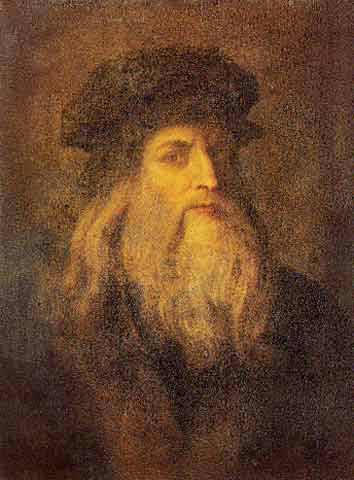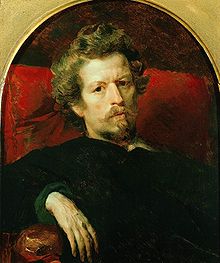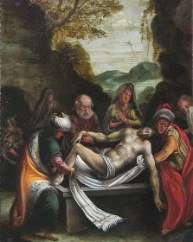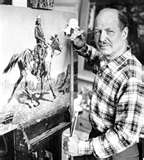






In the Christian Gospels, the Last Supper (also called the Mystical Supper) was the last meal Jesus shared with his Twelve Apostles and disciples before his death. The Last Supper has been the subject of many paintings, perhaps the most famous by Leonardo da Vinci. Our first painting (from left to right) is regarded as one of the greatest works of religious art - The Last Supper (Italian: Il Cenacolo or L'Ultima Cena) a 15th century mural painting in Milan created by Leonardo da Vinci for his patron Duke Ludovico Sforza and his duchess Beatrice d'Este. Here the Passover meal with the Apostles is depicted. The Last Supper took place in what is called today The Room of the Last Supper on Mount Zion, just outside of the walls of the Old City of Jerusalem, and is traditionally known as The Upper Room. It was the last meal before the arrest and crucifixion of Christ.
According to what Paul the Apostle recounted (1 Corinthians 11:23–26), in the course of the Last Supper, and with specific reference to eating bread and drinking from a cup, Jesus told his disciples, "Do this in remembrance of me". In the Synoptic Gospels (The Gospel of Luke, the Gospel of Matthew and the Gospel of Mark), Jesus institutes a new covenant of his blood and body, the wine and bread. Many Christians describe this as the "Institution of the Eucharist also called Holy Communion, Sacrament of the Table, the Blessed Sacrament, or The Lord's Supper. It is here that Jesus announces one of his twelve Apostles would betray him. Despite the assertions of each Apostle that it would not be he, Jesus is described as reiterating that it would be one of those who were present, and goes on to say that there shall be woe to the man who betrays the Son of Man! It would be better for him if he had not been born. Jesus revealed that the one who would betray him would be Judas Iscariot.
The second painting, The Cross (1838), by Karl Pavlovich Briullov (Russian: Карл Павлович Брюллов), called by his friends the Great Karl (12 December 1799 – 11 June 1852) was a Russian painter. He is regarded as a key figure in transition from the Russian neoclassicism to romanticism. The painting depicts the most profound time in history - the crucifixion of Christ. According to the Canonical (accepted as part of the New Testament) Gospels after the Last Supper, Jesus and his disciples travel to Gethsemane, a garden located at the edge of the Kidron Valley, thought by scholars to probably have been an olive grove. Once there he is described as leaving the group so that he can pray privately.
The synoptics state that Jesus asked God that his burden be taken from him, and requesting not to need to undergo the events that he was due to, though giving the final choice to God. Luke states that an angel appeared and strengthened Jesus, who then returned to his disciples, while the other synoptics just state that he returned. The synoptics state that the three disciples that were with Jesus had fallen asleep, and that Jesus criticized them for failing to stay awake even for an hour, suggesting that they pray so that they can avoid temptation. The synoptics state that Jesus went and prayed again, and again the disciples were asleep when he returned, and that after berating them a second time he prays a third time. It is here that Jesus experiences Hematidrosis (also called hematohidrosis) a very rare condition in which a human being sweats blood. It may occur when a person is suffering extreme levels of stress, for example, facing his or her own death. Jesus experienced hematidrosis when he was praying in the garden of Gethsemane (Luke 22:44).
At this point Judas appears on the scene, and the Synoptics add that Jesus alerts the disciples to this before Judas approaches closely. Judas is accompanied by a crowd that the Synoptics indicate as a crowd sent by the chief priests and elders (Mark includes "teachers of the law"). John adds that the crowd included some soldiers and officials from the chief priests and Pharisees (at various times a political party, a social movement, or a school of thought among the Jewish citizens that flourished during the Second Temple Era (536 BCE–70 CE). It is possible that John is referring to the Sanhedrin police force (Kilgallen 271). According to the Synoptic Gospels, Judas identified Jesus to the soldiers by means of a kiss. This is the kiss of Judas, also known (especially in art) as the Betrayal of Christ, which occurs in the Garden of Gethsemane after the Last Supper, and leads directly to the arrest of Jesus by the police force of the Sanhedrin (Kilgallen 271). Regardless, when the band of men entered the garden in search of Jesus, Jesus stepped forth and asked them, "Whom seek ye?" They answered that they were indeed seeking Jesus of Nazareth. Jesus replied and spoke, "I am He", at which point all members of the arrest party fell back and on the ground.-(John:18:4-7). After Jesus' arrest and trial by the Sanhedrin or Jewish Council, according to Matthew's gospel, Judas is filled with remorse and tries to return to the Pharisees the thirty pieces of silver he received for his betrayal, saying he "betrayed innocent blood." When the priests refuse and say that his morals are his own affairs, Judas angrily throws the money into the temple, leaves, and subsequently hangs himself. The book of Acts states that Judas used the money to buy a field, where he fell headlong, "his body burst open and all his intestines spilled out." The field is specifically known as Akeldama or "Field of blood."
The crucifixion of Jesus and his ensuing death is an event that occurred during the first century A.D. Jesus was arrested, tried, and sentenced by Pontius Pilate to be scourged, and finally executed on a cross. The charges brought against Jesus were primarily of blasphemy for claiming to be God, claiming to be the King of the Jewish faith, and for allegedly violating various laws under the laws of Moses, which governed Jewish life. When the Jewish leaders' plan to kill Jesus first arose, they explained in John 10:33: '"For a good work we do not stone You, but for blasphemy; and because You, being a man, make Yourself out to be God."' However, the Bible portrays the true motivation for the trial as being political, rather than religious. The rulers, who had been hand-picked themselves by the Romans, were afraid that the Roman Empire occupying their country would view Jesus' following among the people as yet another uprising, prompting a military attack by Rome to crush a rebellion by the Jewish people.
Collectively referred to as the Passion, Jesus' redemptive suffering and death by crucifixion represents a critical aspect of the doctrine of salvation in Christian theology. Christians regard Jesus as the Messiah, and understand his death as necessary for the forgiveness of sins, a doctrine generally known as atonement. According to the New Testament, Jesus was arrested in Gethsemane following the Last Supper with the twelve Apostles. Traditionally, the Twelve Apostles include Peter (whom some denominations consider the "Prince of the Apostles"); Andrew, James the Greater, James the Less, John, Philip, Bartholomew, Matthew, Thomas, Thaddeus, Simon, and Judas Iscariot., and after the death of Judas Iscariot, Matthias became one of the Twelve. Jesus was forced to stand trial before the Sanhedrin, Pontius Pilate, and Herod Antipas, before being handed over for crucifixion. After being flogged, Jesus was mocked by Roman soldiers as the "King of the Jews", clothed in a purple robe, crowned with thorns, beaten and spat on. Jesus then had to make his way to the place of his crucifixion.
Once at Golgotha, Jesus was stripped and nailed to the beam and hung between two convicted thieves. According to Mark's Gospel, he endured the torment for some six hours, from the third hour until his death at the ninth hour. The soldiers affixed a sign above his head stating "King of the Jews" in three languages, divided his garments and cast lots for his seamless robe, and offered him wine mixed with gall to drink, before eventually piercing his side with a spear to be certain that he had died. The gospels mention a total of seven statements that Jesus made while he was being crucified, as well as several supernatural events that occurred, The gospel writers record seven statements uttered by Jesus while he was on the cross:
-
- "Father, forgive them, for they know not what they do." (Lk 23:34)
- "Truly, I say to you, today you will be with me in Paradise."(Lk 23:43)
- "Woman, behold, your son!"(Jn 19: 25-27)
- "E′li, E′li, la′ma sa‧bach‧tha′ni?"(Mt 27:46) (Mk 15:34) (Aramaic for "My God, My God, why have you forsaken me?")
- "I thirst."(Jn 19:28)
- "It is finished."(Jn 19:30)
- "Father, into your hands I commit my spirit!"(Lk 23:40)
While Jesus is hanging on the cross, the sky is "darkened for 3 hours," from the sixth to the ninth hour (noon to mid-afternoon). Both Roman orator Julius Africanus and Christian theologian Origen refer to Greek historian Phlegon as having written "with regard to the eclipse in the time of Tiberius Caesar, in whose reign Jesus appears to have been crucified, and the great earthquakes which then took place"[ The synoptic gospels state that the veil of the temple was torn from top to bottom. According to Josephus, the curtain in Herod's temple would have been nearly 60 feet (18 m) high and 4 inches (100 mm) thick. According to Hebrews 9:1-10, this curtain was representative of the separation between God and man, beyond which only the High Priest was permitted to pass, and then only once each year (Ex 30:10) to enter into God's presence and make atonement for the sins of Israel. (Lev. 16) Bible expositors agree that the rending of the veil is symbolic of Jesus establishing a new and living way of access to God (Heb. 9:11-15). In her 1944 book 'Poem of the Man God' Italian writer and mystic Maria Valtorta (who had no medical education) provided a very detailed account of the death of Jesus that supports a cardiovascular collapse theory, compounded by partial asphyxiation, and she wrote that the account was dictated to her by Jesus himself in a vision. Endocrinologist Nicholas Pende expressed agreement with Valtorta's account and expressed surprise at the level of detail in which Valtorta depicted Christ's spasms in Crucifixion
Following his death, his body was removed from the cross by Joseph of Arimathea and buried in a rock-hewn tomb, with Nicodemus assisting. Although there is no final consensus regarding the specific year or day, it is generally agreed by biblical scholars that it occurred during the governorship of Pontius Pilate (between AD 26 and AD 36) on a Friday on or near Passover (Nisan 15). Several analyses based on astronomical data and computer simulations agree on the date Friday April 3, 33 AD.
The third painting (atop) Entombment of Christ, oil on wood, by François Clouet (c. 1510 – 22 December 1572) who was the son of Jean Clouet, a French Renaissance miniaturist and painter, particularly known for his detailed portraits of the French ruling family. The painting depicts the scene from the Gospels' accounts of Joseph of Arimathea and Nicodemus taking Christ down from the cross after his crucifixion (John 19:38-42). In Byzantine art the topic became popular in the 9th century, and in the West from the 10th century. The Descent from the Cross is the 13th Station of the Cross. Stations of the Cross (or Way of the Cross; in Latin, Via Crucis; also called the Via Dolorosa or Way of Sorrows, or simply, The Way) refers to the depiction of the final hours (or Passion) of Jesus, and the devotion commemorating the Passion. The tradition as chapel devotion began with St. Francis of Assisi and extended throughout the Roman Catholic Church in the medieval period. It is less often observed in the Anglican and Lutheran churches. It may be done at any time, but is most commonly done during the Season of Lent, especially on Good Friday and on Friday evenings during Lent. The object of the Stations is to help the faithful to make a spiritual pilgrimage of prayer, through meditating upon the chief scenes of Christ's sufferings and death. It has become one of the most popular devotions for Roman Catholics, as well as featuring in the worship and devotion of other Christian denominations. Other figures not mentioned in the Gospels who are often included in depictions of this subject include St. John the Evangelist, who is sometimes depicted supporting a fainting Mary (as in the work below by Rogier van der Weyden), and Mary Magdalene. The Gospels mention an undefined number of women as watching the crucifixion, including the Three Marys, (Mary Salome being mentioned in Mark 15:40), and also that the Virgin Mary and Mary Magdalene saw the burial (Mark 15:47). These and further women and unnamed male helpers are often shown.
The Risen Lord by Arnold Friberg, (born December 21, 1913 in Winnetka, Illinois) is an American illustrator and painter noted for his religious and patriotic works. He is perhaps best known for his 1975 painting The Prayer at Valley Forge, a depiction of George Washington praying at Valley Forge. He is also well known for his 15 "pre-visualization" paintings for the Cecil B. DeMille film The Ten Commandments which were used to promote the film worldwide and for which he received an Academy Award nomination. He has been admitted as a lifetime member of the Royal Society of Arts.
In 1968, Friberg was commissioned by Chevrolet to create a series of paintings showing the greatest moments in college football for use in their 1969 advertising campaign. After extensive research on the location during winter and the equipment and gear used by Revolutionary War soldiers, Friberg created his 1975 masterpiece The Prayer at Valley Forge. This depicts George Washington praying while the Continental Army winters at Valley Forge in Pennsylvania during 1777 and 1778. In 1977, he was commissioned to create a series of saloon paintings for the Golden Nugget in Las Vegas, Nevada. Due to his previous work with the RCMP, Friberg was commissioned to paint HRH The Prince of Wales and his horse Centennial (great-grandson of Man o' War). This led to an additional commission in 1990 to paint a portrait of Queen Elizabeth II, also with Centennial. Both portraits were painted at Buckingham Palace.
He also did a series of paintings depicting scenes from the Book of Mormon for the Church of Jesus Christ of Latter-day Saints.
And on the third day Jesus Christ rose. In the Christian Gospels, the Resurrection of Jesus was the return to bodily life of Jesus after his death by crucifixion. The Resurrection of Jesus is not to be confused with the Ascension of Jesus into heaven. Christian doctrine, ritual and theology are based on the life, death, and resurrection of Jesus being actual events in history. Most Christians accept the New Testament chronicle in all four Gospels as a historical account of Jesus' resurrection which is central to their faith. The New Testament states that after Jesus was executed by Roman crucifixion and entombed, he then was raised from the dead on the third day. (Jn 19: 30-31), (Mk 16:1), (Mk 16:6). His empty tomb was found by his followers. (Mt 28:1-7), (Mk 16: 1-8), (Mk 6:3), (Lk 24: 1-12), (Jn 20: 1-12). He appeared to many people over a span of forty days (Acts 1:3) before his return to heaven (Ascension) (Acts 1:9-10). Christians commemorate these events annually from Easter Sunday to Ascension Day.
The Great Commission, in Christian tradition, is the instruction of the resurrected Jesus Christ to his disciples that they spread his teachings to all the nations of the world. It has become a tenet in Christian theology emphasizing mission work, evangelism, and baptism. It has been a primary basis for Christian missionary activity. Some Christian denominations believe that the Great Commission and other prophecy was fulfilled in the apostolic age (The Apostolic Age of the history of Christianity is traditionally the period of the Twelve Apostles, dating from the Crucifixion of Jesus (c. 26–36) and the Great Commission until the death of John the Apostle (c. 100).
The words and works of this story have been told and written for centuries. It represents the beginning of a new faith, worship and reverence for God through the trials and tribulations of a man commissioned by God. He came to experience the human suffering and offer complete redemption for those that believe. In all of history, it is the most fascinating life ever lived, and the greatest story ever told. Continue on with us as we meet the authors of this epic....